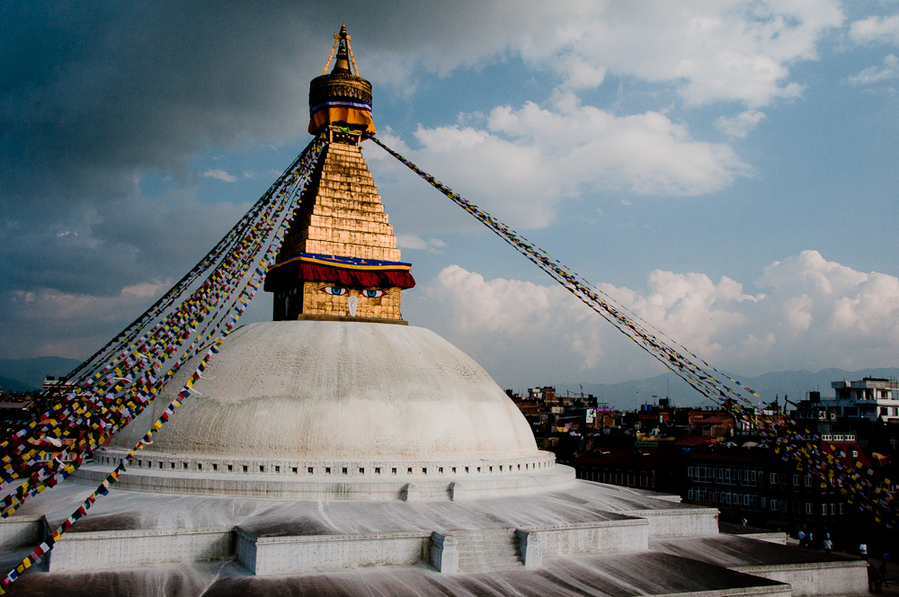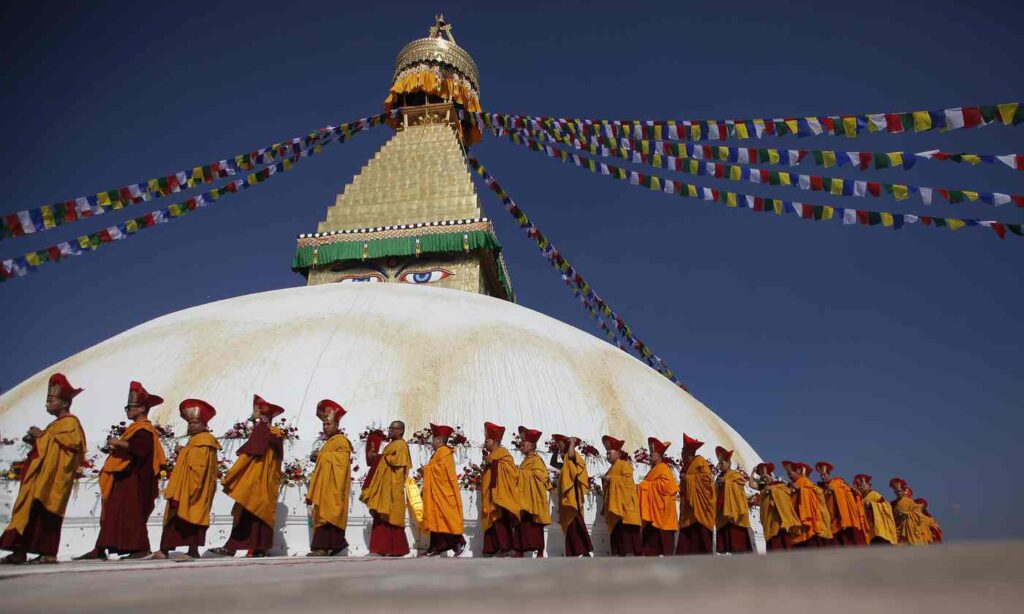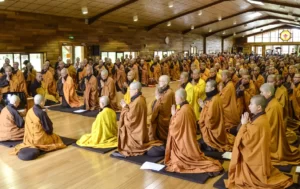Nestled in the sacred space of Kathmandu is the Boudhanath Stupa, a beacon of spirituality and a jewel of Tibetan Buddhist architecture. As you approach this UNESCO World Heritage Site, you’ll be immediately captivated by its monumental presence, enveloped by the iconic gaze of Buddha’s eyes, watching the flow up down of life.
Revered by monks, pilgrims and tourists, Boudhanath is not only a monument but also a vibrant center of centuries-old rituals, prayers and traditions. If you have a chance to visit the beautiful country of Nepal, LotusBuddhas recommend you to visit Boudhanath Stupa.
History and cultural significance of Boudhanath Stupa
Boudhanath Stupa often regarded as one of the most iconic and significant monuments in Nepal. When you delve into its history, you’re not merely discovering story of a monument but a reflection of Nepal’s rich Buddhist heritage.
Dating back to the 14th century, Boudhanath Stupa, also known as the ‘Boudha Stupa’, stands as a symbol of enlightenment. Legend has it that it was built to enshrine the remains of Kasyapa Buddha. Over the centuries, it’s become a focal point for Tibetan Buddhism in Nepal. This association isn’t coincidental. After the Chinese occupation of Tibet in the 1950s, many Tibetan refugees found solace and began to reside around Boudhanath, further amplifying its importance in the Tibetan Buddhist world.
Culturally, the stupa holds an invaluable role in the lives of the locals. Rituals, festivals, and ceremonies, notably the Tibetan New Year (Losar), see throngs of devotees circumambulating the monument, turning the prayer wheels embedded in its base and sending forth a symphony of chants. If you were to visit during these times, you’d be immersed in a profound spiritual experience that transcends beyond mere sightseeing.
The region around Boudhanath Stupa has evolved into a hub for Buddhism. Monasteries, shrines, and Tibetan markets envelope the stupa. Here, one can find traditional artifacts, thangka paintings, and myriad Tibetan goods – ideal for those of you keen to take a tangible memory of Nepalese culture home.
In 1979, Boudhanath Stupa was recognized by UNESCO as a World Heritage Site, an acknowledgment of its cultural, historical, and architectural significance. This designation not only underscores its value but also ensures that future generations can appreciate its beauty and learn from its rich tapestry of history.
Where is Boudhanath Stupa located?
Situated approximately 7 kilometers northeast of Kathmandu’s central district, Boudhanath is well connected by the city’s arterial roads. You can easily identify its towering presence, crowned by the iconic Buddha eyes that gaze serenely in all four cardinal directions. These symbolic eyes serve not only as spiritual emblems but also as unmistakable landmarks for travelers navigating the urban maze of Kathmandu.
If you’re staying within Kathmandu’s central areas such as Thamel or Durbar Square, a myriad of transportation options are at your disposal. Taxis are readily available and are a comfortable choice, especially for those of you unfamiliar with Kathmandu’s hustle and bustle. While making the journey, you might choose to use “Boudhanath Stupa” or simply “Boudha” as your destination keyword with taxi drivers or in digital navigation tools to ensure an accurate journey trajectory.
For the more adventurous souls, local buses plying Kathmandu-Pashupatinath-Boudhanath route provide an authentic experience of local life. If you decide to embark on this journey, it’s recommended to ask locals or your accommodation’s front desk for bus numbers and timings. The route is relatively straightforward, but the experience is enriched manifold when you’re equipped with local knowledge.
Upon nearing Boudhanath, the urban landscape starts to mirror the Tibetan Buddhist influence, with prayer flags fluttering and the gentle hum of chants becoming more discernible. This subtle transition serves as an intuitive guide leading you to the stupa’s entrance.
Architectural features of Boudhanath Stupa
Boudhanath Stupa, a pinnacle of Buddhist architecture in Kathmandu, Nepal, offers an intricate amalgamation of symbolism, design and spiritual significance.
At the base of Boudhanath Stupa, you’re greeted by a massive mandala, which immediately sets it apart as one of the largest spherical stupas in Nepal. This architectural feature, inherently symmetrical, is symbolic of the universe in Buddhist cosmology. For those of you seeking to understand its design, envision a three-dimensional representation of the cosmos.
Ascending from this base are the terraces, reminiscent of the steps to enlightenment in the Buddhist path. As you circumnavigate the stupa, you’ll encounter numerous prayer wheels inscribed with the mantra “Om Mani Padme Hum”. Each rotation of these wheels by devotees sends forth prayers and is believed to accumulate merit.
Perhaps the most iconic architectural feature of Boudhanath Stupa are Buddha eyes or the ‘Wisdom Eyes’, painted on all four sides of the square tower. Gazing in the cardinal directions, these eyes symbolize the omniscience of the Buddha. Between the eyes, you’ll notice a depiction of a numeral, which represents the nose. However, it’s not just any numeral; it’s the Nepali character for the number one, signifying the one path to enlightenment, and it doubles as a symbol of unity. Above the eyes, the 13 pinnacles that rise represent the stages one must pass through to attain Nirvana.
The gilded canopy, or the ‘harmika’, crowns the stupa and is yet another noteworthy feature. It is here that you’ll find the conical structure symbolizing the 13 heavens in Buddhist cosmology. As your eyes trace this upward journey, it culminates in the gilded spire adorned with umbrellas, denoting the stages of enlightenment.
The stupa’s surroundings also play a pivotal role in its architectural narrative. The fluttering prayer flags, often found tied from the stupa’s pinnacle to its base, represent the five elements: earth, water, fire, air and space. Moreover, around Boudhanath, you will find smaller stupas and statues of various deities, each adding layers to the rich tapestry of religious iconography.
Rituals associated with Boudhanath Stupa
One of the most observable rituals at Boudhanath Stupa is the act of ‘kora’ or circumambulation. Devotees, often with mala beads in hand, walk clockwise around the stupa, a practice believed to accumulate merit. As you join in or simply observe, you’ll note the resonance of murmured mantras and the rhythmic turning of prayer wheels, which are believed to release prayers and blessings into the world.
In addition to the daily rituals, the stupa comes alive during specific Buddhist festivals. Among them, the Tibetan New Year, or Losar, holds special significance. During this time, Boudhanath becomes a vibrant epicenter of prayers, offerings, and ceremonies. If you’re fortunate enough to visit during Losar, you will witness monks chanting, butter lamps illuminating the night, and an atmosphere imbued with both reverence and celebration.
Another ritual that captivates observers is the periodic renovation of the stupa. Every few years, the stupa is whitewashed, and the iconic Buddha eyes are meticulously repainted, a process that revitalizes its spiritual and aesthetic aura. This ritual is a testament to the community’s commitment to preserving the sanctity and beauty of Boudhanath.
For those seeking a deeper connection, the lighting of butter lamps is a profound ritual. These lamps, often kindled with wishes and prayers, represent the dispelling of darkness and ignorance, illuminating the path towards enlightenment. As you light one, it becomes a beacon of your personal hopes and a tribute to the collective consciousness.
Adjacent to the main stupa, you’ll discover a plethora of smaller shrines and temples. Each of these holds its own set of rituals, from daily pujas to annual ceremonies, contributing to Boudhanath’s spiritual mosaic.
The best times to visit Boudhanath Stupa
When you chart your journey, selecting the optimal time to visit can greatly enhance your engagement with this UNESCO World Heritage Site. The post-monsoon months of October to November are often deemed the best time to visit Boudhanath Stupa.
During these months, the skies over Kathmandu are clear, unveiling breathtaking views of the Himalayas. The pleasant weather, characterized by cool mornings and evenings, provides the perfect backdrop as you circumnavigate the stupa or partake in rituals. For those of you keen on photography, the crisp light during this period accentuates the architectural nuances and the vibrant hues of prayer flags.
The spring months of March to May also present favorable conditions. While temperatures are slightly warmer compared to the autumn months, the vibrant blossoms and clear skies make it another ideal window for your Boudhanath visit. As you stroll around, the fragrant scent of blooming flowers adds an additional sensory layer to the experience.
For those seeking a more profound cultural immersion, aligning your visit with significant Buddhist festivals can be transformative. Losar, the Tibetan New Year, usually falling between February and March, sees Boudhanath pulsating with ceremonies, prayers, and an outpouring of devotion. If you’re looking to experience the stupa in its full ceremonial grandeur, this period should be high on your consideration list.
However, if serene contemplation is what you’re after, it’s recommended to visit Boudhanath during the early mornings or late afternoons, irrespective of the season. These times not only evade the midday rush but also offer a meditative ambiance, heightened by the soft chants of monks and the gentle glow of butter lamps.
Conversely, the monsoon months of June to September might be challenging due to intermittent rains and overcast skies, potentially hindering outdoor activities. But for those of you with a penchant for the offbeat, the rains cast a mystical aura over Boudhanath, with fewer tourists and a unique atmosphere of introspection.
Notes for visitors when visiting Boudhanath Stupa
When visiting the venerable Boudhanath Stupa in Kathmandu, Nepal, careful preparation can enhance your experience many times over. This site is not only an architectural marvel but also a sacred space of reverence and tradition. Understanding this, LotusBuddhas would like to offer some notes for your reference:
- Dress Respectfully: Boudhanath Stupa is a site of profound spiritual significance. You should opt for modest attire, ensuring that your shoulders and knees are covered. This gesture is not only a mark of respect but also aligns with local cultural norms.
- Circumambulation: When walking around the stupa, always move in a clockwise direction. This tradition of circumambulation, known as ‘kora’, is deeply rooted in Buddhist practices. As you join the stream of devotees, you’ll find this ritualistic motion to be meditative and introspective.
- Photography Etiquette: While Boudhanath offers countless photographic opportunities, always be sensitive to the surroundings. Avoid capturing monks or devotees in private prayers without permission. Respect any signage or areas where photography might be restricted.
- Engage with Local Practices: If you wish to turn the prayer wheels, do so with your right hand and in a clockwise direction. Lighting a butter lamp or offering a prayer flag can be a deeply personal experience, but it’s essential to approach these rituals with reverence.
- Guided Tours: For those of you keen on understanding the rich history, architectural nuances, and spiritual significance of Boudhanath Stupa, consider engaging a local guide. Their insights can provide a deeper layer of appreciation and understanding of the site.
- Avoid Public Displays of Affection: Nepali culture, in general, is conservative regarding public displays of affection. You should avoid actions like hugging or kissing while within the precincts of the stupa.
- Local Artisan Shops: The area around Boudhanath boasts numerous local artisan shops selling traditional crafts, thangka paintings, and other souvenirs. As you explore these, remember to bargain politely. It’s not just a commercial transaction but an engagement with local culture and traditions.
- Stay Hydrated and Nourished: The area around Boudhanath offers a plethora of cafes and eateries. You can savor local delicacies, with many establishments providing rooftop views of the stupa, making for a memorable dining experience.
- Safety and Belongings: As with any major tourist attraction, always be mindful of your belongings. While Boudhanath is generally safe, it’s wise to keep valuables secure and be aware of your surroundings.
Visiting Boudhanath Stupa is not just a visual treat but a profound cultural and spiritual immersion. As you weave through its history, rituals, and traditions, Boudhanath promises to leave an indelible mark on your consciousness.
Boudhanath Stupa stands as a testament to centuries of devotion, art and spiritual pursuits. As you immerse yourself in its captivating atmosphere, you will not simply witness an architectural masterpiece but also immerse yourself in the living tapestry of Tibetan Buddhist beliefs. In an ever-changing world, Boudhanath provides a sanctuary where ancient wisdom meets contemporary quests, inviting you to pause, reflect and reconnect with the profound mysteries of existence.











